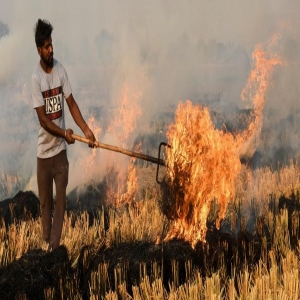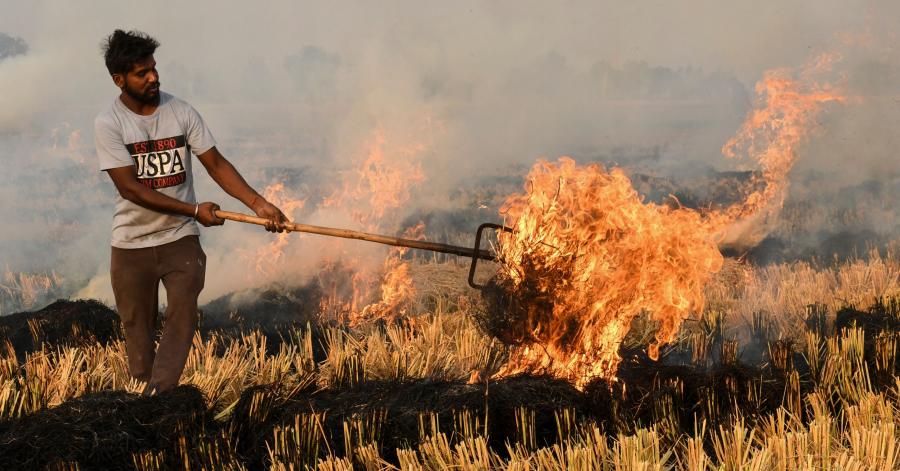

Climate consciousness among Indians is certainly growing, but we tend to view climate change as a potential, rather than an imminent, threat, which invites immediate behavioural changes. Second, even as more and more people switch to electric vehicles and other renewable energy sources, the population, particularly among those who depend on coal, wood, petrol, diesel, kerosene, and other non-renewable sources of energy, is still rising rapidly.
It is not merely Delhi; the Central Pollution Control Board (CPCB) of India data project that cities in Uttar Pradesh, such as Lucknow and Kanpur and many cities across India are wobbling under rising levels of air pollution.
As the majority of India's population lives in rural areas, air pollution in these areas cannot be ignored, and pollution cannot be attributed solely to traffic exhaust, factory emissions, and construction dust. It is worthwhile to consider that around 80 per cent of rural households depend on biomass, such as wood and dung, for cooking and other purposes, and agricultural practices like burning crops are also prevalent. Hence, there is a need for a faster transition to climate-sensitive practices.
Despite a surge in the temperature of the atmosphere, accompanied by warnings of severe heatwaves and news of frequent earthquakes and cyclones, the issues that affect people more on a daily basis in their perception are not climate-induced challenges. Even though uneven weather, shortfalls of rain, and droughts are climate-induced, farmers are more worried about the Minimum Support Price (MSP) and the lack of irrigation facilities than about climate change.
Many people in India believe that they cannot do anything about climate change. Many others ascribe some extra-terrestrial reasons, and some attach religious beliefs to such changes in weather patterns. Industrialists often resist meeting the environmental standards that come with the extra costs of green technology, but they are more inclined to accept higher profits and even happier about avoiding heatwaves by switching on their air conditioners, which in turn emit hydrofluorocarbons (HFCs)—a significant source of greenhouse emissions.
Amidst extreme heatwaves in many parts of India, people are often seen rallying around their leaders, and the cavalcade contributes to carbon emissions, while leaders travel in large vehicles powered by either petrol or diesel. Political leaders do not think the results of their elections would be any different if they raised climate consciousness among people. Rather, they are sure that more meetings, gatherings of people, and bike rallies will yield better electoral results for them. Some of us also do not mind firing off numerous crackers on occasions such as marriages and favourite festivals. The people have yet to integrate climate-sensitive values into their behavioural patterns, and leaders have yet to encourage them to do so. This will require a shift from climate consciousness to engagement in climate-sensitive practices.
Climate Change and India's Commitments
India's Prime Minister Narendra Modi has made significant commitments on several international platforms on behalf of India to reduce carbon emissions and make a swift transition to renewable energy resources. Most notably, India and France founded the International Solar Alliance (ISA) on the sidelines of the G20 Summit in 2015, underlining India's proactive approach to global climate issues. The initiative aimed to promote solar energy and reduce dependency on fossil fuels. This was considered a milestone in projecting India as a leader in championing renewable energy resources and as a votary of sustainable development. Moving a step forward in this direction, in 2021, at COP26, India significantly increased its climate mitigation commitments by pledging to reach net-zero emissions by 2070. In 2022, it updated its Nationally Determined Contribution.
Despite the pledges that India is committed to at the national and international levels, data suggest that India's economy, as well as its citizens' everyday lives, is still over-reliant on coal and imported crude oil. While coal is its primary source of fuel, accounting for approximately 70% of electricity generation, much of its transport is powered through imported oil. As a result, India is the world's third-largest emitter of carbon dioxide despite the fact that it still emits a lower percentage of carbon per capita. Second, the commitments and their implementations fall far short of the immediacy of the climate needs and population bulge. For instance, India's pledge to reach net-zero emissions by 2070 is akin to aiming to attain a goal when climate change would have damaged the environment to such an extent that it would have significantly impacted the lives of every Indian, let alone the vulnerable sections.
To quote India's Union Environment Minister Bhupender Yadav's response to a question in a Press Conference on December 19, 2023: "India is committed to meeting the energy needs of its people and will also have to rely on coal power until it achieves developed country status." He was further quoted saying: "But the developed countries are pressuring developing nations to end the use of fossil fuels. We did not accept it (at COP28). We said efforts to (limit temperature rise to) 1.5 degrees Celsius should be seen in light of national circumstances."
The argument that developed countries owe more responsibility towards climate preservation due to their long-term environmental damage since the Industrial Revolution, given their updated technology and capital, can be pursued by India at its own peril. The principles of equity and common but differentiated responsibilities and respective capabilities were stressed by the Union Environment Minister. While this line of thinking may be logical, the Global South, including India, cannot pursue this argument in the long term. India's need for advanced green technology and capital can be met by mobilising resources from developed countries in the West and international financial institutions, such as the World Bank and the IMF, through diplomatic efforts. Apart from this, the government can explore and expand the base of its indigenous green technologies and resources.
Approaches to environmental concerns in India are changing, but they need to reflect in an individual's day-to-day behaviour. The Supreme Court of India not only broadly interpreted the right to life under Article 21 of the Constitution, including the right to a healthy environment, but it emphasised the need to set up specialised environment courts for the effective and expeditious disposal of cases involving environmental issues.
Governmental institutions and civil society groups can not only make people aware, but the Indian government also has the primary responsibility to encourage and finance practices that will help inculcate eco-friendly habits among the rural and urban masses. In the context of the rising culture of consumerism, the dictum of the father of the Indian nation, MK Gandhi, assumes significance and further relevance: "Earth provides enough to satisfy every man's needs, but not every man's greed". India, a growing and globalising economy, fosters artificial needs that are more a result of greed than actual necessity.